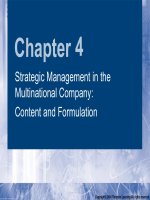đề thi Midterm cross cultural management
Bạn đang xem bản rút gọn của tài liệu. Xem và tải ngay bản đầy đủ của tài liệu tại đây (709.45 KB, 7 trang )
MINISTRY OF EDUCATION AND TRAINING
NATIONAL
ECONOMICS
own
UNIVERSITY
EXAM
MANAGEMENT
Time: 6h45
Time allowed : 60 minutes
Delivery: Full-time
Intake: 62
tua
FACULTY OF BUSINESS MANAGEMENT
OF QUALITY
MIDTERM
CULTURAL
Date: 24/03/2023
TE gy
Am:
NA
MANAGEMENT
CROSS
ANDINNOVATION
IN ENGLISH (EMO/)
Name: ............................
ST 2S S2 HH re
Student ID:..........................
2. cSSSSnSSSS se.
| TEST CODE: 01 |
1.
What are main characteristics of culture?
(A.Culture
2.
is shared, learned, systematic and organized
B.
Culture is shared, learned and innate
C.
Culture is learned, systematic and organized, innate
D.
Culture is shared, innate, systematic, and organized
All of the following are value dimensions proposed by Hofstede EXCEPT
A. uncertainty avoidance
communism
C. power distance
D. individualism
3.
Phil sent an email requesting Mel to join him in the conference room at 2 P.M. and to bring
the final report on the building's floor plans. However, Mel's personal secretary skips
reading the entire email and just informs Mel to join Phil in the conference room at 2 P.M.
This is an example of
A.
ambiguity
B.
divergence
Cores
anything that serves to undermine the communication of the intended meaning
. feedback
4.
Work-motivation theories can be broken down into two general categories, which are:
A. method and outcome.
B.
internal and external.
C.
implicit and explicit.
ontent and process
5.
Which of the following statements is true about expatriates? nguoi’song tha huong
A. Historically, multinational corporations (MNCs) have refrained from staffing key
positions in their foreign affiliates with expatriates.
B. They are individuals from a host country who are assigned to work in the home
©
country.
They are those who live and work outside their home country.
D. Multinational corporations (MNCs) find it advantageous to use expatriates
because their salary and benefit package is less than that of host-country nationals
are managers who are citizens of countries other than the one in which a
multinational corporation (MNC) is headquartered or the one in which they are assigned
to work by the multinational corporation (MNC).
__A. Multipatriates
(Bs Home-country nationals
C. Inpatriates
D. Third-country nationals
Which of the following is most likely the last stage of negotiation?
A. analysis of an opponent's position
B. relationship building
fC.# concessions and agreement
D. training
Comparative approach to culture does not help the manager predict change in the culture
and explain why groups and individuals are led to modify their values through interaction
with each other. This reflects which weakness of cultural models?
A. The use of national culture as unit of analysis
- _B. The descriptive nature of cultural models
CG The static nature of cultural models
D. The lack of consideration for subculture
According to PIPA test, people who focuses on framework and prefer working with high
level of clarity is said to be driven by
A. Idea
B. Action
C. People
c “D Process
10. Culture affects mental programming at an intermediate level because itis
and
Yanna?
A.
Specific to individuals and inherited and learned
B. Specific to groups and biological
oo
OS
See
Ế ì Specific to groups and learned
. Universal and learned
11.
is a set of knowledge structures consisting of systems of values, norms, attitudes,
beliefs, and behavioral meanings that are shared by members of a social group (society)
and embedded in institutions and learned from previous generations.
A. Value
B. Norm
C.
=
§
Basic assumption
“Dry yCulture
TNgaaaoaast
12. According to Hofstede, the extent to which subordinates accept a hierarchical system in a
company is known as
.
A. uncertainty avoidance
fon
\B.} power distance
C. individualism
D. masculinity
13. Based on Hofstede's value dimensions, countries that have strict laws and procedures to
which their people adhere closely most likely have
A. high power distance
B. high masculinity
ec “high uncertainty avoidance
“SS high individualism
14. The term
refers to behavior that communicates without words.
A. thought patterns
CB} nonverbal communication
Ÿss
C.
intrapersonal communication
D. cultural noise
15. Which of the following is a true statement regarding kinesic behavior?
A. Facial expressions have the same meaning across cultures.
B, Minor variations in body language are insignificant.
f
(È. \Hand gestures are universally interpreted.
16. ThÈTffeaning of body movements varies by culture.Researchers
have
suggested that
Maslow's theory needs a(n)
A.
—_—
prey
capitalist perspective
' B. Scollectivist perspective
Saw B.S
C.
individualist perspective
D. social individualist perspective
17. This leadership style 1s
, who believe that final
decisions should be in the hands of the higher-level employees and that a continued focus
on the t task is compatible with the kind of people they are dealing with.
CAL ~ Authoritarian
B. Suppressive
C. Paternalistic
D. Laissez-faire
18. Which of the following statements is true about h
Ax They are third-country nationals who are assigned to work in the home
iB. “Whey are |
who are citizens of the country where a
Se multinational corporation (MNC)is headquartered.
C.
country.
They are managers who are citizens of countries other than the country in which
the multinational corporation (MNC) is headquartered.
D. They are likely to be used by multinational corporations (MNCs) at the middleand lower-level ranks.
19. These leaders are visionary agents with a sense of mission who are capable of motivating
their followers to accept new goals and new ways of doing things.
A. Transactional
B. Negotiable
+ .WTransformational
~"Formational
20. One of the primary purposes of r
during the negotiation process is to
——»e KE——.
(A. Ybuild mutual trust
B. create formal contracts
C. exchange task-related information
D. avoid direct confrontations
21. The considerable variation between Americans and Chinese in the use of silence during
meetings 1s an aspect of
A.
proxemics
s ine
B. haptics is
CCC2paralanguage )
D.
object language
jg used in ps
22. Which of the following is a ‘characteristic o0 ]
_ “A™Authority
isi diffused throughout the bureaucratic system.
eens
Enns
SANSA
—
‘B"" Insiders and outsiders are easily distinguishable.
C. Relationships between people are relatively long lasting.
D. People in authority are personally responsible for the actions of their subordinates.
“
23. Which of the following is a characteristic of a]
A. Deep personal involvement with others is not valued greatly.
B. Individuals are taught from a very early age to say exactly what they mean.
C. Insiders and outsiders are not readily distinguishable.
“Dy Agreements tend to be spoken rather than written.
24. IBNThas strong corporate culture but this does not prevent it from having striking cultural
differences among its staff across different countries and has limited lasting impact. This
example indicates that the effect of
may be weaker that of
A. Organizational culture, group culture
‘B Organizational culture, national culture
TƯ Natonal culture, organizational culture
D. National culture, group culture
25. An organization that has
is an organization that focuses on external
positioning with a high degree of flexibility and individuality.
A. Family culture
B. Bureaucratic culture
C. ‘Innovation culture
¥ Market culture
26.
a pattern of basic assumptions, invented, discovered, or developed by a
given group, as it learns to cope with its problems of external adaptation and internal
integration, that has worked well enough to be considered valid and, therefore is to be
taught to new members as the correct way to perceive, think, and feel in relation to chosen
problems.
A. Individual culture
B.
Group culture
fmm
en. Organizational culture
D. National culture
27. Culture is gained through the process of interacting with the social environment and culture
is not merely random
assortments
of attitudes, customs
and behaviors but integrated
coherent system. This statement shows which 2 characteristics of culture respectively?
A. Shared and learned
BS Learned and systematic
C. Shared and systematic
D. Learned and shared
28. Nations
are political entities, they vary in their forms
educational
systems, labor, and employment
of government,
relations systems,
legal systems,
all of which reflect a
working cultural consensus. This statement is in favor of which argument about the concept
of national culture?
A. Reject the use of the concept
3, Support the use of the concept
C.
Sha
Qiipes
SUE
Neither support or reject
D. Have no relation to the use of the concept
29. Identify the style of leadership that has been widely espoused in the United States
England, and other Anglo countries.
A.
B.
Cc.
Paternalistic
Transformational
Transactional
CD. `Rarticipative
30. French and German managers tend to use a work-centered,
xi
aN . authoritarian
ae
B"” autocratic
approach to leadership.
C. paternalistic
D. participative
31. All of the following are accurate depictions of the Japanese approach to leadership
except:
A. management's concern for its employees extends to the whole life, business and
social, of the worker.
B. decision making is carried out via group decision-making techniques
¬ employment is often for life; layoffs are rare.
\D.. écontrol mechanisms are very explicit; people know exactly what to control and
how to do tt.
32. Which of the towing |IS a primary characteristic o
(A assertivenessshai do khang dink, qua quyst
B
C.
D.
33. Which
A.
emphasis on eroup “achievements.
1"
tight social frameworks
lack of gender bias
of the following is NOT one of Trompenaars's value dimensions?
universalism versus particularism
B. neutral versus affective
` specific versus diffuse
Ồ À masculinity versus femininity
34. In which of the following societies are people more likely to pass on inside information
to a friend?
“VA. Darticularistic
B. universalistic
C. neutral
D. affective
35. The tendency of Americans to look people in the eye contrasts with the tendency of the
British to keep looking away while conversing. Such differences are categorized as
fay Joculesics
are
:
subtie differences in eye behavior
“8. proxemics
C. paralanguage
D. object language
36. Which of the following will a person working in a high-contact culture most likely
experience?
A. coworkers spending time together socially
B. managers using hand motions to express emotion
C. managers bowing to their seniors as a token of respect
( D'\coworkers putting an arm over their colleague's back
—c
refers to how something is said rather than the content—1.e., the rate of
37.
speech, the tone and inflection of voice, other noises, laughing, or yawning.
A. Proxemics
«8 ) Paralanguage
C. Object language
D. Kinesic behavior
38. Managers from Singapore, New Zealand, and Hong Kong tend to take initiative and have
a sense of urgency, and the confidence to get things done. According to the GLOBE
project, such managers score high on the cultural dimension of
A. humane orientation
B. future orientation
Cc -}performance orientation
39.
“1” assertiveness
describes the process of sharing meaning by transmitting messages through
media such as words, behavior, or material artifacts.
A. Ethics
CB? Communication
C. Planning
D. Strategy
40. The three basic elements in the process of motivation are:
A. needs, abilities, and desires.
B. desires, drives, and accomplishments.
8¬ needs, drives, and goal attainment.
““D. perceptions, attitudes, and goal attainment.
41. The assumptions of the contingency approach to leadership include all of the following,
except:
A. Different situations require different styles of leadership.
B. The leaders need to be able to understand the characteristics of the organizations
. they lead.
Gì ì Leaders do not need to adapt their behavior to fit the situation they lead.
D. Leadership requires consideration of both trait and behavior approaches.
42. Fiedler’s contingency model of leadership suggests all of the following, except:
A. Effective group performance is based on the match between the leader’s style and
the degree to which the situation enables the leader to exert influence.
B. It considers the leader’s style in terms of tasks and relationships.
ott considers key situational factors such as the degree of the task, the power of the
~~ follower in the situation, and the relationship with the follower.
D. Relationship oriented leaders will be most effective when the situation provides
control.
43. The path-goal theory proposes that a directive behavior will be most effective in all of the
following circumstances, except:
A. Where the demands of the task are ambiguous.
"BS
Where procedures are clear.
Noo
C. Where rules are unclear.
D. Where employees are somewhat dogmatic.
44, Which theory states that people are born with certain characteristics that predispose them
to being leaders?
Ặ
Ñ lait theory
Says {al there are ceriain characteristics and hablual patterns present in a person
B. nath- goal theory
C. LPC
D. contingency theory
45. Three situational criteria identified in the Fiedler model are:
A. a. job requirements, position power, and leadership ability.
B. b. charisma, influence, and leader-member relations.
‘a Cc. leader-member relations, task structure, and position power.
D. d. task structure, —_
ability, and group conflict
N
ke
E He elies che
thrị2Gi9fS GP
MOONY
AK
a that an
tinge Woy Fe
oe S ASSUMES
War an
*
.~
ing
rich ving
ta
Ms
ậu
ti
G
Jershin
78113
*
styie is fixed
St MAES HNC.









